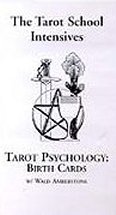|
Tarot Reflections |
January 17, 2005 |
| Review: Tarot Psychology: Birth Cards Valerie Sim, CTGM |
|||||||||||||||||
|
Figuring Out Your Birth Cards In Ms. Greer’s treatise the birth cards are differentiated as “Personality” and “Soul” Cards, whereas for the Amberstones, the Birth Cards are always a pair. Ms. Greer goes on to elaborate on Personality, Soul and even Year cards, while the Amberstones confine themselves to the Birth Card Pair, but analyze them in great depth and detail. Another difference between the two systems is the way in which the birth cards are determined. In Ms. Greer’s system you add as though doing an equation. To use my birth date, February 23, 1954, it looks like this:
The sum is then added linearly like this 1 + 9 + 7 + 9 = 26. Since 26 is a number greater than 22, or the number of the highest Trump, the two digits are again added, 2 + 6 = 8, and I find myself to be a “double 8”, or one whose Soul and Personality cards are the same. In the Amberstones’ system, the math is handled differently. They add the month and date together to get one number, and then add that number to the first two digits (or the century) and the last two digits (or the year within the century). Thus, for my birth date:
The digits in 98 are added together, 9 + 8 = 17. Being under 22, that 17 gives me the first card in my birth pair (The Star), and adding the digits 1 and 7 together, for 1 + 7 = 8, gives you the second card in my birth pair, 8 or Strength. So in the Amberstones’ system, and for the purpose of this review, I am a “Star/Strength.”
I have “revealed” the mathematics for both of these systems simply because knowing that is only the beginning in both Ms. Greer’s system and the one taught by Ruth Ann and Wald Amberstone. If you are interested in Ms. Greer’s system, please buy her book. I recommend it highly. If you are interested in the one presented by the Tarot School in this series of tapes, please read on. And if you think that you know all you need to know about either simply by virtue of being able to do the math, you have, as my mother likes to say, “another think coming.” What You Learn in This Course This course teaches you the basic birth card signatures, how to factor them, how to delineate them, what each signature/pairing means and how to apply that pairing in your readings. Sound simple? In theory, yes. But the detail into which the Amberstones take their analysis is staggering. In order to do the review, I found myself taking twelve pages of notes on the amazing amount of material covered. I learned how to analyze not just the cards themselves, but how to contrast my pair’s posture, colors, eye direction, flow of energy, symbolism, etc. I was led to see how they are alike and how they are different. I learned to contrast them in multiple ways in order to understand the basic conflicts within the pairing. And though I learned a lot by contrast, I learned even more by the realization that all birth card pairs represent a continuum wherein each card is a gatepost at each end of that scale. Getting a feel for that continuum and its many nuances was what made the whole system come alive for me. Better yet, I didn’t just earn about my cards. I also learned about all of the other birth card pairs in order to be able to gain a new perspective on all of those for whom I read the Tarot. Even more invaluable, was the way in which knowledge about birth card pairs helped me to see what makes those with whom I come into daily contact “tick.” Just knowing someone’s birth date (and no time of birth necessary as with astrology) can be a huge eye opener and a great help in interpersonal relationships. In Summation The best reason to get the Tarot Psychology: Birth Cards segment from the Tarot School is to better understand the Tarot Psychology: Elemental Array course also available from the Tarot School… and vice versa. Both courses are stand alone and yet supplement each other exponentially. Neither are available elsewhere and both are recommended heartily. With either or both of those systems you can do an insightful and complex Tarot reading without ever laying out the cards in the traditional manner. Tarot Psychology: Birth Cards and other courses from the Tarot School are available here: http://www.tarotschool.com/Tapes.html Illustrations from the Rider-Waite-Smith Tarot Deck reproduced by permission of U.S. Games Systems, Inc. , Stamford, CT 06902 USA. Copyright ©1971 by U.S. Games Systems, Inc. |
||||||||||||||||
|
|
|||||||||||||||||
|
Subscribe to Tarot Reflections, and receive notification of each update! |
|
Request to be added to the list by sending email to TarotReflections-subscribe@yahoogroups.com! |
All articles remain the
property of their respective authors.
Tarot Reflections is a publication of the American Tarot Association
- Copyright (C) 2005
Questions or Comments? Contact Us.




